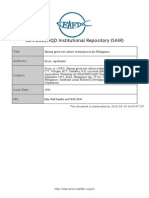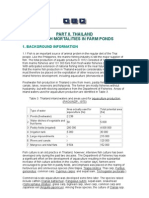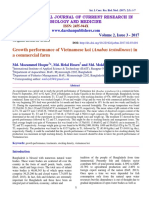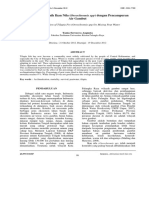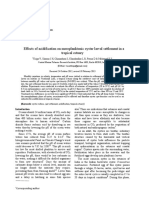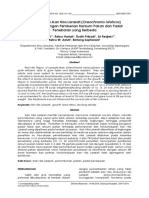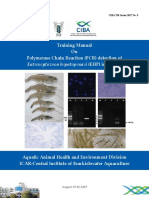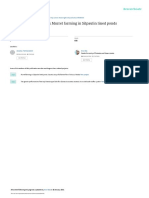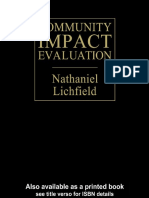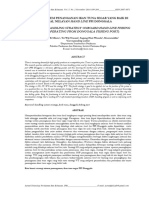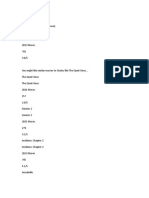Professional Documents
Culture Documents
Growth, Survival and Biomass of Etroplus Suratensis in Shallow Water Cages Installed at Gopalpur Creek, Bay of Bengal, India
Copyright
Available Formats
Share this document
Did you find this document useful?
Is this content inappropriate?
Report this DocumentCopyright:
Available Formats
Growth, Survival and Biomass of Etroplus Suratensis in Shallow Water Cages Installed at Gopalpur Creek, Bay of Bengal, India
Copyright:
Available Formats
Volume 6, Issue 7, July – 2021 International Journal of Innovative Science and Research Technology
ISSN No:-2456-2165
Growth, Survival and Biomass of Etroplus suratensis
in Shallow Water Cages Installed at Gopalpur Creek,
Bay of Bengal, India
N. K. Sial, G.C. Kund, D. Satapathy
Post-Graduate Department of Aquaculture,
College of Fisheries
Odisha University of Agriculture & Technology (OUAT),
Berhampur-760007, Odisha, India
Abstract:- With an intention to integrate artisanal level shrimps and crabs in small cages suitable for such shallow
of capture based aquaculture with the sustainable waterbody.
management practices of small scale fisheries an attempt
has been made through this study to collect juveniles and The selection of species needs to be based on their
sub adults of Pearl spot Etroplus suratensis from abundance, duration and above all the suitability of aquatic
Gopalpur creek and to stock in small cages installed in system for its growth and survival. On the contrary the
the same waterbody to observe its growth so as to adoption of CBA under small scale fisheries in shallow
develop a package of practices for local fishers as an waterbody without appropriate measures may increase the
option of additional income. Three sets of cages with risk of spreading pathogens and water pollution. Authors
three replicas of each one were fixed and sub adults of [1], [4], [.7], [9], [12], reported on various aspects i.e.
Etroplus suratensis were stocked at the rate of 15, 20 and raising fish in small cages in estuaries, adoption of cage
25 nos per m2 for a period of 150 days. During the period culture, supplementary feeding and growth rates,
of experiment temperature fluctuated from 24.6- 31.8oC, advantages, dis-advantages and risk of such practices in
water pH from 8.1- 8.5, Water transparency from 14.2 – Indian context whereas [2], [11], [13], reported on
32.9 cm, Dissolved oxygen from 5.0- 6.9 ppm, and water production aspects. [3], [5] and [8] reported on failures of
salinity from 5.3- 21.3 ppt in the cage installation site. management aspects and suggested to make necessary
The daily growth rate (DGR) marked a fluctuation from adjustments accommodating the biological, agricultural and
0.347 to 0.593 g/day while the specific growth rate (SGR) socio-economic realities.
fluctuated from 0.48 to 0.75%. More production was
obtained from cages stocked with more stocking density. II. MATERIALS & METHODS
Keywords:- Gopalpur Creek, Etroplus Suratensis, Shallow A. Study Area
Water Cage, Daily Growth Rate, Specific Growth Rate, Gopalpur Creek lies between 19o 16’ 22” Nand 19 o
Survival and Biomass. 15’ 39” N Latitude and between 84 o 54’ 0.6” E and 84o
55’15” E Longitude is a typical brackish water ecosystem
I. INTRODUCTION spreading over 8-10 km2. It is influenced by agriculture run-
off from one side and tidal ingress from other side through
The capture based aquaculture is a kind of farming its mouth located in East side. Usually, the mouth, the inlet
technology where fish seeds/ juveniles/sub adults are caught of the creek varies from 25 to 40 meter in monsoon with a
in its early stages from a definite waterbody and is grown to depth of 3 to 4 meters separating two sand dunes. However,
its adult size or marketable size in captive conditions. It this inlet gradually gets filled up in sand due to littoral
generates more profits; ensure employment and marketing. drifting of water current prevalent in Gopalpur bay and
It has the potential to generate profits when compared to becomes 25-30 meters in width with 0.5 to 1.0mt in depth
other aquaculture activities to a greater extent leading to during summer months. Heavy influx of sea water continues
socio economic development of a region. It would be to take place through the inlet into the creek throughout the
appropriate to integrate artisanal level of capture based year in each high tide and discharge into the sea in
aquaculture or indigenous methods of culture with the corresponding low tide. Therefore, varied forms of marine
sustainable management practices in tune with small scale organisms enter to the creek including fish and shrimp
fisheries (SSF) in India. Small-scale fishing dominates in juveniles and larval forms. Besides, the sea water and fresh
many countries including India. It needs low investment, water discharge develop a brackish water environment and
indigenous gears, indigenous technical knowledge (ITK) serves as estuarine habitat for fish, shrimp, crabs and oysters
simple skill and an easy approach. In this regard, the shallow and bivalves etc.
waterbody like estuaries, creeks and tidal lagoons etc. offer
excellent scope for practice, particularly growing fish,
IJISRT21JUL1122 www.ijisrt.com 1082
Volume 6, Issue 7, July – 2021 International Journal of Innovative Science and Research Technology
ISSN No:-2456-2165
During monsoon often entry of fish and shrimp larvae weight gain and the result was expressed in g. The Specific
takes into the creek water. Many of them goes back to the growth rate was estimated following standard formula =
sea and a few makes its habitat in the creek which serves as (100 x (LN final weight – LN initial weight) /days)) taking a
the source of capture fisheries to nearly 700 fisher families sample size of 25% from each cage. Critical water quality
inhabiting in the bank of creek i.e. Gopalpur fishermen parameters like temperature and dissolved oxygen (DO)
village and Haripur village. The creek is leased out to the were observed on daily basis using temperature probe and
fishermen society on annual basis for the purpose of capture digital DO meter while routine parameters i.e. transparency,
fisheries. The excess runoff of freshwater during monsoon pH, and salinity were ascertained at fortnight intervals
and brings down the salinity and provides ample of following sechi disc method and using pH meter and
opportunity for fresh water fishes. Gradually, the water salinometer respectively. The repair of cages and cleaning
converts to brackish water soon after monsoon ends and and replacement of nets etc., were carried out as and when
further increases to become saline later on. Subsequently, necessary.
owing to restricted ingress of seawater and excess of
evaporation makes the system hypersaline. III. RESULTS AND DISCUSSION
B. Species Selection Out of three treatment cages of set I, the first cage with
Realizing the need of promotion of artisanal fisheries a stocking density of 15nos/m3, where fish juveniles of size
in Gopalpur creek, Odisha by way of enhancing fish below 45mm/42g were stocked recorded its body weight
production, it was thought of to retain fish and shrimp seeds/ gain of 47g, 58g,75g, 100g and 130g during 30 days, 60
juveniles available during monsoon which otherwise go days, 90days, 120days and 150 days of culture while in the
back to the sea, and to grow them in small shallow water 2nd cage the body weight enhanced from 45g to 48g, 55g,
cages as a source of additional income. An attempt was 70g, 105g and 125g and in third cage fish grew from initial
made to observe the growth of pearl spot fish Etroplus sp in 48g upto 54g, 65g, 78g, 115g and 137g in 30th, 60th ,90th,
cages, so that a definite programmer can be developed for 120th and 150th days of culture. The daily growth rate
wise use of its resources. Pearl spot, is indigenous to Indian (DGR) varied 0.59g, 0.53g and 0.59 with a mean of 0.571 ±
continent and Srilanka. It inhabits in estuarine conditions 0.03 g./day and specific growth rate (SGR) fluctuated from
and has high capacity for acclimatization to freshwaters at 0.681% to 0.753% with a mean of 0.711 ± 0.03 %.
all size groups. Filamentous algae and detritus constitute the Similarly, in the 2nd set of experimental cages with a
major food for the fish in its habitat. The species having stocking density of 20 no’s/m3 fishes stocked between 45-
browsing / ‘scraping’ behavior keep the cages free from 55mm/42-48g recorded maximum growth up to 122 g in 4th
fouling and mesh clogging algae. cage followed by 120g in 5th cage and 115g in 6th cage
indicating mean DGR of 0.493 ± 0.04 g/day and SGR of
C. Fabrication and installation& stocking and monitoring 0.649 ± 0.06 % while the 3rd set of cages of stocking
Three sets of experimental cages (each set having three density of 25 no’s/m3 where fishes between 45-55mm/ 42-
each) were fixed closure to the inlet so as to take the 48g recorded maximum growth up to 112g in 7th cage
advantage of water flow during high and low tide. Cages of followed by 110g in 8th cage and 100g in 9th cage resulting
rectangular size 2.0 m x 1.0 m x 1.2 m made of locally mean DGR of 0.415 ± 0.06 g/day and SGR of 0.579 ±
available bamboo splits with 15 mm gaps between bamboo 0.08 %. Statistical analysis (ANOVA) indicated no
splits were fabricated by the local fishermen. Nylon significant variation of growth of fish within cages and
mosquito nets of 0.5 mm mesh size were tied as an inner significant variation of growth within months. Added,
layer to protect fish from abrasion and avoid loss of feed survival rate of fishes was relatively high (87-93%) in 1st set
pellets. The cages were kept in fixed position by towing it in followed by 2nd and 3rd set of cages (80-87%). But
prefixed bamboo poles interlocking in a line in such a way maximum biomass was obtained from 7th cage (5.00kg)
that the width of cage faces water current so that water can followed by 4th& 8th cage (4.600kg each), 9th cage (4.400
pass through all the three cages thus making it very efficient kg), 5th& 6th cage (4.00 kg each), 3rd cage (3.800kg), 1st cage
in water exchange. Bamboo barricade was provided for each (3.600 kg) and 2nd cage (3.200 kg) indicating higher biomass
location to protect the cage from floating weeds and in cages having more stocking density in spite of relatively
turbulence due to tidal force. The outer opening of cage is low survival rate.
provided with a cover made of same bamboo split wrapped
with mosquito cloth to protect against sunlight and birds. Experiments on cage culture in India indicated yield
Seeds/ juveniles of pearl spots, Etroplus suratensis, of size rates range from of 0.7 to 1.3 kg/m3/month [7] while, [9]
between 45-55 mm / 42-48 gm collected from the same reported total fish production of 16.03 kg/m3/year. Author
waterbody and were stocked at three different densities of [4] recorded an average fish production of 26.76± 9.308kg
15, 20 and 25 nos./ m2 in three different sets of cages. The (range 17.80- 44.40) kg/m3 in 205.3 ± 60.9 days of culture
stocked fishes were fed twice a day with dry pellets at the with a record of 0.50-0.90 g growth per day at a survival rate
rate of feeding were adjusted according to biomass 5-7% varying between 45 and 100%. The fish attained maximum
adjusting to the biomass of the cage. size of 350-480 g at harvest (average size of 163.76 ±
40.214g) at a specific growth rate ranged from 0.27 to
The weight gain of fish was determined by subtracting 0.76% leading to a situation of more the production from
initial weight from final weight. This weight gain is divided higher the stocking density (230 no’s/ m3).
by number of culture days to ascertain the average daily
IJISRT21JUL1122 www.ijisrt.com 1083
Volume 6, Issue 7, July – 2021 International Journal of Innovative Science and Research Technology
ISSN No:-2456-2165
Growth performance of pearl spots (E. suratensis) to dissolved oxygen it marked non-significant variation within
an extent of 0.593 g/day at Gopalpur creek throughout this months and sites. All the water parameters were suitable for
study appears less than the results obtained by [4] from growth of fish during the period of experiments.
Venbenad lake of Kerala but certainly better considering its
natural growth in open waters of Gopalpur creek. The Usually, unused feeds settle below the cages if not
growth rate of Pearl spot is comparatively much slow than dispersed through water current and such accumulation lead
many estuarine fishes, hardly growing to 120-130 g. The to decomposition and depletion of oxygen level. On the
attainment of 137g in 150 days in shallow water system event of prolonged situation, biological oxygen demand
encourages its possibilities of cages culture. Fish production (BOD) increases. Author [15] reported very low levels near
increases with increase of stocking size limiting to its cages. However, high oxygen levels between5.2 ppm to 6.9
maximum growth phase and similarly with stocking density ppm observed at the cage installation site in the present
considering its carrying capacity. But in the present study indicative of stress free situation. Added the water
investigation such kind of result was not recorded. It could circulation through cages compensated the dissolved oxygen
be due to the fact of stocking of oversize fish in cages. This concentration of water in fish cages. So it confirms good
implies that higher stocking density would have fetched exchange of water between cage and open water in the
more production. The mortality rates were low when present study and minimal clogging and fouling of nets and
stocking size and stocking density was more without much cages. The low transparency (below 20 cm) recorded in the
fluctuation. The observed biomass 2.50 kg/m3 of pearl spot months of July, August and September was the effect of
under cage culture is satisfactory for the study. Higher sediment transport because of littoral drift phenomenon
stocking density and frequent feeding results, increased prevalent in Gopalpur bay coupled with mixing of silt laden
production in cage fish farming particularly for carnivorous rain water flow from the adjacent catchment areas. Added,
fed fishes but not for pearl sopt with browsing feeding frequent rains and very low levels of salinity often
habits. The results also confirm that pearl spot adapts well in associated with the risk of disease outbreak in caged fishes.
low to moderate volume cages suitable for shallow In the present study neither any indication of disease nor its
waterbody which could be due to its schooling behavior. occurrence was noticed.
Therefore, higher stocking stocking density to an extent of 4
to 5 time would be possible. IV. CONCLUSION
The net cages stocked with pearl spots were free from Based on the growth performance of Pearl Spot E.
clogging of algae and fouling of biofilms due to its algal suratenis as recorded in the present experiment, it is
browsing behavior and algal grazing tendency mostly on concluded that there is a possibility to undertake shallow
filamentous algae and detritus as evidenced from the water cage culture in the Goplpur creek by the local
findings of [6], [10] and [16]. The bamboo sticks and its fishermen community either at individual or family or
supported pieces acted as good substrates for the growth of through fishermen’s’ cooperative society. However,
filamentous algae and bio-film that served as an additional considering evidences of failures in cage farming
source of natural food for the fish. management practices in spite of inclusion of small-scale
fish farming in Africa in the late 1950s and early 1960s as a
The values of physic-chemical parameters of water in means of improving the quality of life for poor farmers as
the cages like temperature, dissolved oxygen, transparency reported by (Kalinga, 1991) adequate precautions need to be
and pH were well within tolerable limits of fish. However, taken and suitable practice of packages need to be followed
in set I cages (C-1, C-2 & C-3) where fishes were stocked at before adopting such technologies in this waterbody.
a density of 15 no’s/m3 water temperature fluctuated from
24.6 oC (Dec) to 31.1 oC (August) at a mean of 29.0 ± REFERENCES
2.4oC., dissolved oxygen from 5.2 ppm to 6.9 ppm (6.00 ±
0.70 ppm), transparency 14.2 cm to 32.9 cm (23.5± 7.2cm), [1]. A.L. Baiju, S.D. Neetha, S. Shyam, S.K. Sukumaran4,
water pH from 8.1 to 8.5 (8.3 ± 0.14) and salinity from 10.5 and R.B. Pramod, “Effects and consequences of small-
pot (August) to 21.3 pot (16.9± 4.5 pot). Similarly, in set II scale cage culture technology adoption in Kerala”
cages (C-4, C-5 & C-6) temperature fluctuated from 25.2 oC Proceedings: National Seminar on Faunal Diversity of
- 31.8 oC. ( 29.1 ± 2.6 oC.), dissolved oxygen from 5.0 - 6.1 Kerala, 2012, pp. 78-82.
ppm( 5.5 ± 0.41), water transparency from 15.4cm- 37.5 cm [2]. B. Hu, and Y. Liu, “Development of cage culture and
( 23.1 ± 9.06 cm), water pH from 8.2- 8.5 ( 8.4 ± 0.10) and its role in fishery enhancement in China”, FAO
salinity from 11.3 – 20.8 ppt ( 16.5± 3.9 ppt) and in set III Fisheries Technical Paper No.374. FAO, Rome, 1997,
cages ( C-7, C-8 & C-9) water temperature fluctuated from pp. 255-278.
25.3 oC - 31.5 oC ( 29.3 ± 2.4 oC), dissolved oxygen from [3]. B.A. Costa-Pierce, and R.S.V. Pullin, “Development
5.2 ppm- 6.5 ppm ( 5.9 ± 0.54 ppm), transparency from of smallholder aquaculture in Malawi,” World
15.7 cm – 31.7 cm ( 22.0 ± 7.3 cm), water pH from 8.2-8.5 Aquacult, vol. 23(1), 1992, pp. 43-48
( 8.4 ± 0.10) and salinity from 5.3 ppt- 21.2 ppt ( 14.1 ± 6.0 [4]. K. G, Padma Kumar, P.S. Manu, and L. Bindu, “Open
ppt) during the period of study. ANOVA test indicated water farming of pearl spot Etroplus suratensis
significant variation within months (P< 0.05) for both water (Bloch) in low-volume cage,” Asian Fisheries Science.
temperature and water salinity and non-significant variation Vol. 22(2), 2009 pp. 839-847
(P>0.05) within experimental site. But for water pH and
IJISRT21JUL1122 www.ijisrt.com 1084
Volume 6, Issue 7, July – 2021 International Journal of Innovative Science and Research Technology
ISSN No:-2456-2165
[5]. K.L. Cichrame, “Reconciling sustainability, economic Li and Jack Mathias), Elsevier, Amsterdam, 1994, pp.
efficiency and quality in fisheries: the one that got 305-346.
away?” Fish and Fisheries, vol. l (1), 2000, pp. 3-21 [12]. S. Parameswaran, “Unconventional aquaculture
[6]. L. Bindu, and K.G. Padma Kumar. “Food of the pearl systems. Cages and pens”. In: Summer institute on
spot, Etroplus suratensis (Bloch) in the Vembanad recent advances in freshwater aquaculture (ed. S.
lake, Kerala”. Journal of the Marine Biological Tripathi), CIFA, Bhubaneswar, India, 1993, pp. 58-69.
Association of India, vol. 50 (2), 2008, pp. 156-160 [13]. S. Zainal, and P. Effendi, Implementation of
[7]. M.K. Bandhyopadhyay, “Pen and cage culture – extension for net-cage aquaculture in Indonesian
effective management options for increasing fish reservoirs: pitfalls and prospects. In: Inland fishery
production from flood plain wetlands” In: Fisheries enhancements (ed. T. Petr), FAO Fisheries Technical
Management of Floodplain wetlands in India, Bulletin Paper No.374. FAO, Rome, 1998, pp. 245-254.
No. 125. Central Inland Fisheries Research Institute, [14]. S.B. Chakraborty, D. Mujumdar, S. Banerjee,
Barrackpore, India, 2003, pp. 204-211. Determination of ideal stocking density for cage
[8]. O.J.M. Kalinga, “The evolution-of fish farming in culture of monosex Nile tilapia (Oreochromis
Malawi” (abstract), ICLARM Conf. Proc., 1991, pp. niloticus) in India, Proceedings of the Zoological
27: 52 Society, Springer-Verlag, vol. 63 (1), 2010, pp. 53-59
[9]. P. Kumaraiah, 2006, “Cage and pen culture”, In: [15]. S.C. Vargasmachuca, J.T. Ponce-Palafox, E.C. Ortíz
Handbook of Fisheries and Aquaculture. (ed. S. and J.L. Arredondo-Figueroa. “Effect of the initial
Ayyappan), pp. 335- 353. stocking body weight on growth of spotted rose
[10]. P.S. Keshava, Joseph and M.M. Joseph, “Feeding snapper Lutjanus guttatus (Steindachner, 1869) in
habits of the pearl spot Etroplus suratensis (Bloch) in marine floating cages”, Revista de Biología Marina
the Nethravati-Gurpur estuary, Mangalore. In: Oceanografía, vol. 42(3), 2007, pp. 261-267.
Proceedings of the First Indian Fisheries Forum (ed. [16]. V. Jayaprakas, and K.G. Padmanabhan “Food and
M. Mohan Joseph), 1988, pp. 203-206. feeding habit of the Pearl spot, Etroplus suratensis
[11]. S. Li, “Fish culture in cages and pens”, In: Freshwater (Bloch)”. Proceedings of the Symposium on Coastal
fish culture in China, Principles and practices (ed. Sifa Aquaculture. Marine Biological Association of India.
Part 3, 1985, pp. 955-963.
TABLE 1. Water quality in the cage sites during the period of cage culture practice in Gopalpur creek, East coast of India.
1st 90
Water parameters day 30 days 60 days days 120 days 150 days
3
Stocking density (15nos/m ) Jul Aug Sep Oct Nov Dec
Temperature (oC) 30.0 31.1 30.8 29.6 27.9 24.6
Dissolved Oxygen(DO) 5.2 5.6 5.6 5.7 6.8 6.9
Transparency (cm) 17.4 14.2 20.8 26.3 29.5 32.9
Water pH 8.1 8.2 8.4 8.5 8.4 8.3
Salinity (ppt) 12.3 10.5 17.4 19.3 20.7 21.3
Stocking density (20 nos/m3)
Temperature (oC) 30.6 31.8 31.2 29.2 26.8 25.2
Dissolved Oxygen(DO) 5.0 5.5 6.1 5.4 5.2 5.9
Transparency (cm) 16.2 15.4 17.3 21.2 37.5 30.8
Water pH 8.3 8.2 8.4 8.5 8.4 8.3
Salinity (ppt) 12.5 11.3 16.4 17.8 20.2 20.8
Stocking density (25 nos/ m3)
Temperature (oC) 30.8 31.5 31.2 29.7 27.4 25.3
Dissolved Oxygen(DO) 5.2 6.1 5.9 5.3 6.4 6.5
Transparency (cm) 15.7 16.3 16.8 20.5 31.7 30.8
Water pH 8.3 8.2 8.4 8.5 8.4 8.3
Salinity (ppt) 5.3 9.4 13.4 15.6 19.8 21.2
IJISRT21JUL1122 www.ijisrt.com 1085
Volume 6, Issue 7, July – 2021 International Journal of Innovative Science and Research Technology
ISSN No:-2456-2165
TABLE.2. Growth, survival and biomass of E. suratensis in experimental cages during 150 days of culture at Gopalpur creek,
East cosat of India
Site –I Site-II Site III
Features
(set-I) (set-II) (set-III)
C-1 C-2 C3 C-4 C-5 C6 C-7 C-8 C-9
3
Cage size (m ) 2.4 2.4 2.4 2.4 2.4 2.4 2.4 2.4 2.4
Cage stocking volume 2.0 2.0 2.0 2.0 2.0 2.0 2.0 2.0 2.0
Stocking density (nos/ m3) 15 15 15 20 20 20 25 25 25
Days of culture (DOC) 150 150 150 150 150 150 150 150 150
Mean stocking size
Weight (g) 42 45 48 42 45 48 42 45 48
Length (mm) 45 50 55 45 50 55 45 50 55
Max. size at harvest
Weight (g) 130 125 137 122 120 115 112 115 100
Length (mm) 125 112 130 128 110 105 110 120 105
Survival (%) 93 87 93 87 80 87 87 80 87
Total Biomass (kg/m3) 1.8 1.6 1.9 2.3 2.0 2.0 2.5 2.3 2.2
DGR ( g. fish/day) 0.586 0.533 0.593 0.533 0.500 0.446 0.467 0.433 0.347
SGR( %) 0.753 0.681 0.699 0.710 0.654 0.582 0.654 0.595 0.489
IJISRT21JUL1122 www.ijisrt.com 1086
You might also like
- Aquaponics Systems, Fish. Volume 6: Sistemas de acuaponíaFrom EverandAquaponics Systems, Fish. Volume 6: Sistemas de acuaponíaNo ratings yet
- Economics of Rainbow Trout Farming System in NepalDocument14 pagesEconomics of Rainbow Trout Farming System in NepalMahesh Paudyal100% (1)
- Lab ErpDocument6 pagesLab ErpPaulo Angelo LimNo ratings yet
- Economics of Rainbow Trout Farming System in NepalDocument11 pagesEconomics of Rainbow Trout Farming System in NepaltasteofnepalNo ratings yet
- Josileen Jose - 2023 - Crab Culture - Course Manual Winter School On Mariculture TechnologiesDocument12 pagesJosileen Jose - 2023 - Crab Culture - Course Manual Winter School On Mariculture TechnologiesTriana DewiNo ratings yet
- Oyster Condition: Research Journal of Chemistry and Environment March 2014Document6 pagesOyster Condition: Research Journal of Chemistry and Environment March 2014Tony NicholasNo ratings yet
- A Hatchery Rearing Method For The Mangrove Red SnapperDocument6 pagesA Hatchery Rearing Method For The Mangrove Red SnapperCriselda FajilagotNo ratings yet
- September 2016: See Discussions, Stats, and Author Profiles For This Publication atDocument17 pagesSeptember 2016: See Discussions, Stats, and Author Profiles For This Publication atalpeshmk1No ratings yet
- Shrimp Grow-Out Culture Technqiues in The PhilippinesDocument12 pagesShrimp Grow-Out Culture Technqiues in The PhilippinesCu UleNo ratings yet
- LIM Et Al 2003 Desenvolvimentos Recentes Na Aplicação de Alimentos Vivos Na Piscicultura de Água Doce OrnamentalDocument13 pagesLIM Et Al 2003 Desenvolvimentos Recentes Na Aplicação de Alimentos Vivos Na Piscicultura de Água Doce OrnamentalDaniel CostaNo ratings yet
- Part Ii. Thailand Catfish Mortalities in Farm Ponds: 1. Background InformationDocument5 pagesPart Ii. Thailand Catfish Mortalities in Farm Ponds: 1. Background InformationaneeshmscNo ratings yet
- Scientific Note Breeding and Seed Production of Green Back MulletDocument4 pagesScientific Note Breeding and Seed Production of Green Back MulletboonyongchiraNo ratings yet
- Evaluation of Integrated Fish-Rice Farming in The Nile Irrigation and Drainage Project Areas, South Gonder, EthiopiaDocument4 pagesEvaluation of Integrated Fish-Rice Farming in The Nile Irrigation and Drainage Project Areas, South Gonder, EthiopiaSyahril FisNo ratings yet
- Feeding Appropriate Formulated Diet For Improving Gonad Maturation and Spawning of Brooder of Some Native Fishes in IndonesiaDocument9 pagesFeeding Appropriate Formulated Diet For Improving Gonad Maturation and Spawning of Brooder of Some Native Fishes in IndonesiaAdrians SAFNo ratings yet
- Growth Performance of Vietnamese Koi (Anabas Testudineus) in A Commercial FarmDocument7 pagesGrowth Performance of Vietnamese Koi (Anabas Testudineus) in A Commercial FarmSandipan SarkarNo ratings yet
- Sea Cage FamDocument8 pagesSea Cage FamAnonymous xv5fUs4AvNo ratings yet
- Vaname Shrimp Cultivation Litopenaeus Vannamei On High Stocking Densities in Controlled PondsDocument6 pagesVaname Shrimp Cultivation Litopenaeus Vannamei On High Stocking Densities in Controlled PondsEl DrogoNo ratings yet
- Fishseedproduction okNYSDocument8 pagesFishseedproduction okNYSVaibhav DoifodeNo ratings yet
- Vannamei Experiment in TNDocument5 pagesVannamei Experiment in TNVijay Varma RNo ratings yet
- Aquaculture Spectrum Nov 2022 Seabass NurseryDocument7 pagesAquaculture Spectrum Nov 2022 Seabass NurseryGeetha EconomistNo ratings yet
- Cage Culture: An Efficient Method for Fish FarmingDocument6 pagesCage Culture: An Efficient Method for Fish FarmingNarasimha MurthyNo ratings yet
- Acclimatization of Tilapia Fry by Mixing Peat WaterDocument5 pagesAcclimatization of Tilapia Fry by Mixing Peat WaterafiahchaerulNo ratings yet
- High Density Catfish Culture in Biofloc SystemDocument7 pagesHigh Density Catfish Culture in Biofloc SystemgitoaryoNo ratings yet
- IJMS 43-9-2014 Kripa Effect of AcidificationDocument7 pagesIJMS 43-9-2014 Kripa Effect of AcidificationArunNo ratings yet
- 18607-Article Text-66749-2-10-20180629Document8 pages18607-Article Text-66749-2-10-20180629Aldo OtangNo ratings yet
- IJZAB ID No. 284 PDFDocument10 pagesIJZAB ID No. 284 PDFIJZABNo ratings yet
- Study of Mud Crab Fattening in Earthen Pen Pond With Different Stocking DensityDocument10 pagesStudy of Mud Crab Fattening in Earthen Pen Pond With Different Stocking Densityteo hui chunNo ratings yet
- j.1749 7345.1992.tb00788.x20160929 23215 9l587k With Cover Page v2Document15 pagesj.1749 7345.1992.tb00788.x20160929 23215 9l587k With Cover Page v2vu BuivanNo ratings yet
- Milkfish Culture: Alternative Revenue For Mandapam Fisherfolk, Palk Bay, Southeast Coast of IndiaDocument15 pagesMilkfish Culture: Alternative Revenue For Mandapam Fisherfolk, Palk Bay, Southeast Coast of IndiaMike-Dave Madarang CastilloNo ratings yet
- Extensive Systems-Inputs Are Cheap and Does Not Require Much Labour and Food ForDocument3 pagesExtensive Systems-Inputs Are Cheap and Does Not Require Much Labour and Food ForKernnia KellyNo ratings yet
- Ras PDFDocument10 pagesRas PDFSID NANDANo ratings yet
- Present and Future For Production in Cages and Enclosures in IndiaDocument6 pagesPresent and Future For Production in Cages and Enclosures in IndiaAnjuNo ratings yet
- "Freshwater Aquaculture" (FAC-211) : BooksDocument154 pages"Freshwater Aquaculture" (FAC-211) : BooksjoshigautaNo ratings yet
- "Freshwater Aquaculture" (FAC-211) : BooksDocument114 pages"Freshwater Aquaculture" (FAC-211) : BooksjoshigautaNo ratings yet
- SEAFDEC/AQD Institutional Repository (SAIR) : This Document Is Downloaded At: 2013-07-02 01:30:14 CSTDocument19 pagesSEAFDEC/AQD Institutional Repository (SAIR) : This Document Is Downloaded At: 2013-07-02 01:30:14 CSTHariz ManafNo ratings yet
- 2013 DietofC CarpioDocument15 pages2013 DietofC CarpioCitea MariaNo ratings yet
- Package of Practices For Increasing Production: NO.3. DEC.'85Document16 pagesPackage of Practices For Increasing Production: NO.3. DEC.'85Deepak J SharmaNo ratings yet
- Eel Culture in IndiaDocument8 pagesEel Culture in Indiaসপ্তক মন্ডলNo ratings yet
- tmpC6F0 TMPDocument23 pagestmpC6F0 TMPFrontiersNo ratings yet
- What Is AquacultureDocument4 pagesWhat Is AquacultureMuthu KumarNo ratings yet
- Growth of Nile Tilapia in Brackishwater PondsDocument12 pagesGrowth of Nile Tilapia in Brackishwater PondsPUTRA122No ratings yet
- Mahseer Breeding and Conservation and Possibilities of Commercial Culture. TDocument18 pagesMahseer Breeding and Conservation and Possibilities of Commercial Culture. TRajpal Singh KochharNo ratings yet
- Farming The ReservoirsDocument6 pagesFarming The ReservoirsInternational Aquafeed magazineNo ratings yet
- GrowthDocument8 pagesGrowthDx RianNo ratings yet
- Recent Advances in Coastal Aquaculture: Imelda JosephDocument4 pagesRecent Advances in Coastal Aquaculture: Imelda JosephNehaNo ratings yet
- Mud Carab Farming in IndiaDocument4 pagesMud Carab Farming in IndiaInternational Aquafeed magazine67% (3)
- Journal of Fisheries & Livestock ProductionDocument7 pagesJournal of Fisheries & Livestock Productiondesikudi9000No ratings yet
- Balai Riset Perikanan Budidaya Air Tawar, Bogor: Jurnal Akuakultur Indonesia, 7 (1) : 71-77 (2008) AvailableDocument7 pagesBalai Riset Perikanan Budidaya Air Tawar, Bogor: Jurnal Akuakultur Indonesia, 7 (1) : 71-77 (2008) AvailableFajrul AfifNo ratings yet
- Growth Performanceof Green Mussel Pernaviridis Transplantedin Buguey Lagoon PhilippinesDocument6 pagesGrowth Performanceof Green Mussel Pernaviridis Transplantedin Buguey Lagoon Philippinesmarian almiaNo ratings yet
- Water Quality Management For Catfish CultureDocument5 pagesWater Quality Management For Catfish Cultureapi-3803371100% (2)
- Open Sea Cage CultureDocument154 pagesOpen Sea Cage CultureAzizah KuswardiniNo ratings yet
- Gouper Culture in Floating Net CageDocument11 pagesGouper Culture in Floating Net Cagebudiku100% (2)
- Indonesian Aquaculture Journal Explores C/N RatiosDocument14 pagesIndonesian Aquaculture Journal Explores C/N RatiosBambang GunadiNo ratings yet
- Aquaculture Appears To Be A Rapidly Expanding Industry and It Offer Opportunities Even On ADocument5 pagesAquaculture Appears To Be A Rapidly Expanding Industry and It Offer Opportunities Even On APing Ping CaresusaNo ratings yet
- Training Manual On PCR Detection of Enterocytozoon Hepatopanaei 17-18 August 017Document52 pagesTraining Manual On PCR Detection of Enterocytozoon Hepatopanaei 17-18 August 017Anonymous VSIrcb4I100% (1)
- Freshwater Cage Fish Farming: Site Selection and Environmental ConsiderationsDocument15 pagesFreshwater Cage Fish Farming: Site Selection and Environmental ConsiderationsFlorentina SuduNo ratings yet
- Jurnal 114Document5 pagesJurnal 114RegineRojoNo ratings yet
- Aquaculture Spectrum 31 Murrel Farming in Silpaulin Lined PondsDocument9 pagesAquaculture Spectrum 31 Murrel Farming in Silpaulin Lined PondsRatna Kumar ManneNo ratings yet
- Koi Fish CultureDocument26 pagesKoi Fish CulturefireflybarakaNo ratings yet
- Sucker FishDocument3 pagesSucker FishSajid MahmoodNo ratings yet
- Automatic Power Factor ControllerDocument4 pagesAutomatic Power Factor ControllerInternational Journal of Innovative Science and Research TechnologyNo ratings yet
- Intelligent Engines: Revolutionizing Manufacturing and Supply Chains with AIDocument14 pagesIntelligent Engines: Revolutionizing Manufacturing and Supply Chains with AIInternational Journal of Innovative Science and Research TechnologyNo ratings yet
- Navigating Digitalization: AHP Insights for SMEs' Strategic TransformationDocument11 pagesNavigating Digitalization: AHP Insights for SMEs' Strategic TransformationInternational Journal of Innovative Science and Research TechnologyNo ratings yet
- A Review: Pink Eye Outbreak in IndiaDocument3 pagesA Review: Pink Eye Outbreak in IndiaInternational Journal of Innovative Science and Research TechnologyNo ratings yet
- Teachers' Perceptions about Distributed Leadership Practices in South Asia: A Case Study on Academic Activities in Government Colleges of BangladeshDocument7 pagesTeachers' Perceptions about Distributed Leadership Practices in South Asia: A Case Study on Academic Activities in Government Colleges of BangladeshInternational Journal of Innovative Science and Research TechnologyNo ratings yet
- Securing Document Exchange with Blockchain Technology: A New Paradigm for Information SharingDocument4 pagesSecuring Document Exchange with Blockchain Technology: A New Paradigm for Information SharingInternational Journal of Innovative Science and Research TechnologyNo ratings yet
- Mobile Distractions among Adolescents: Impact on Learning in the Aftermath of COVID-19 in IndiaDocument2 pagesMobile Distractions among Adolescents: Impact on Learning in the Aftermath of COVID-19 in IndiaInternational Journal of Innovative Science and Research TechnologyNo ratings yet
- Studying the Situation and Proposing Some Basic Solutions to Improve Psychological Harmony Between Managerial Staff and Students of Medical Universities in Hanoi AreaDocument5 pagesStudying the Situation and Proposing Some Basic Solutions to Improve Psychological Harmony Between Managerial Staff and Students of Medical Universities in Hanoi AreaInternational Journal of Innovative Science and Research TechnologyNo ratings yet
- Review of Biomechanics in Footwear Design and Development: An Exploration of Key Concepts and InnovationsDocument5 pagesReview of Biomechanics in Footwear Design and Development: An Exploration of Key Concepts and InnovationsInternational Journal of Innovative Science and Research TechnologyNo ratings yet
- Perceived Impact of Active Pedagogy in Medical Students' Learning at the Faculty of Medicine and Pharmacy of CasablancaDocument5 pagesPerceived Impact of Active Pedagogy in Medical Students' Learning at the Faculty of Medicine and Pharmacy of CasablancaInternational Journal of Innovative Science and Research TechnologyNo ratings yet
- Formation of New Technology in Automated Highway System in Peripheral HighwayDocument6 pagesFormation of New Technology in Automated Highway System in Peripheral HighwayInternational Journal of Innovative Science and Research TechnologyNo ratings yet
- Natural Peel-Off Mask Formulation and EvaluationDocument6 pagesNatural Peel-Off Mask Formulation and EvaluationInternational Journal of Innovative Science and Research TechnologyNo ratings yet
- Drug Dosage Control System Using Reinforcement LearningDocument8 pagesDrug Dosage Control System Using Reinforcement LearningInternational Journal of Innovative Science and Research TechnologyNo ratings yet
- The Effect of Time Variables as Predictors of Senior Secondary School Students' Mathematical Performance Department of Mathematics Education Freetown PolytechnicDocument7 pagesThe Effect of Time Variables as Predictors of Senior Secondary School Students' Mathematical Performance Department of Mathematics Education Freetown PolytechnicInternational Journal of Innovative Science and Research TechnologyNo ratings yet
- Enhancing the Strength of Concrete by Using Human Hairs as a FiberDocument3 pagesEnhancing the Strength of Concrete by Using Human Hairs as a FiberInternational Journal of Innovative Science and Research TechnologyNo ratings yet
- Supply Chain 5.0: A Comprehensive Literature Review on Implications, Applications and ChallengesDocument11 pagesSupply Chain 5.0: A Comprehensive Literature Review on Implications, Applications and ChallengesInternational Journal of Innovative Science and Research TechnologyNo ratings yet
- Advancing Opthalmic Diagnostics: U-Net for Retinal Blood Vessel SegmentationDocument8 pagesAdvancing Opthalmic Diagnostics: U-Net for Retinal Blood Vessel SegmentationInternational Journal of Innovative Science and Research TechnologyNo ratings yet
- The Making of Self-Disposing Contactless Motion-Activated Trash Bin Using Ultrasonic SensorsDocument7 pagesThe Making of Self-Disposing Contactless Motion-Activated Trash Bin Using Ultrasonic SensorsInternational Journal of Innovative Science and Research TechnologyNo ratings yet
- Placement Application for Department of Commerce with Computer Applications (Navigator)Document7 pagesPlacement Application for Department of Commerce with Computer Applications (Navigator)International Journal of Innovative Science and Research TechnologyNo ratings yet
- REDLINE– An Application on Blood ManagementDocument5 pagesREDLINE– An Application on Blood ManagementInternational Journal of Innovative Science and Research TechnologyNo ratings yet
- Beyond Shelters: A Gendered Approach to Disaster Preparedness and Resilience in Urban CentersDocument6 pagesBeyond Shelters: A Gendered Approach to Disaster Preparedness and Resilience in Urban CentersInternational Journal of Innovative Science and Research TechnologyNo ratings yet
- Exploring the Clinical Characteristics, Chromosomal Analysis, and Emotional and Social Considerations in Parents of Children with Down SyndromeDocument8 pagesExploring the Clinical Characteristics, Chromosomal Analysis, and Emotional and Social Considerations in Parents of Children with Down SyndromeInternational Journal of Innovative Science and Research TechnologyNo ratings yet
- Handling Disruptive Behaviors of Students in San Jose National High SchoolDocument5 pagesHandling Disruptive Behaviors of Students in San Jose National High SchoolInternational Journal of Innovative Science and Research TechnologyNo ratings yet
- Safety, Analgesic, and Anti-Inflammatory Effects of Aqueous and Methanolic Leaf Extracts of Hypericum revolutum subsp. kenienseDocument11 pagesSafety, Analgesic, and Anti-Inflammatory Effects of Aqueous and Methanolic Leaf Extracts of Hypericum revolutum subsp. kenienseInternational Journal of Innovative Science and Research TechnologyNo ratings yet
- A Curious Case of QuadriplegiaDocument4 pagesA Curious Case of QuadriplegiaInternational Journal of Innovative Science and Research TechnologyNo ratings yet
- A Knowledg Graph Model for e-GovernmentDocument5 pagesA Knowledg Graph Model for e-GovernmentInternational Journal of Innovative Science and Research TechnologyNo ratings yet
- Analysis of Financial Ratios that Relate to Market Value of Listed Companies that have Announced the Results of their Sustainable Stock Assessment, SET ESG Ratings 2023Document10 pagesAnalysis of Financial Ratios that Relate to Market Value of Listed Companies that have Announced the Results of their Sustainable Stock Assessment, SET ESG Ratings 2023International Journal of Innovative Science and Research TechnologyNo ratings yet
- Pdf to Voice by Using Deep LearningDocument5 pagesPdf to Voice by Using Deep LearningInternational Journal of Innovative Science and Research TechnologyNo ratings yet
- Adoption of International Public Sector Accounting Standards and Quality of Financial Reporting in National Government Agricultural Sector Entities, KenyaDocument12 pagesAdoption of International Public Sector Accounting Standards and Quality of Financial Reporting in National Government Agricultural Sector Entities, KenyaInternational Journal of Innovative Science and Research TechnologyNo ratings yet
- Fruit of the Pomegranate (Punica granatum) Plant: Nutrients, Phytochemical Composition and Antioxidant Activity of Fresh and Dried FruitsDocument6 pagesFruit of the Pomegranate (Punica granatum) Plant: Nutrients, Phytochemical Composition and Antioxidant Activity of Fresh and Dried FruitsInternational Journal of Innovative Science and Research TechnologyNo ratings yet
- Nathaniel Lichfield - Community Impact Evaluation - Principles and Practice-Routledge (1996)Document342 pagesNathaniel Lichfield - Community Impact Evaluation - Principles and Practice-Routledge (1996)Michael González VásquezNo ratings yet
- Project Handout For Masters (Text Book Two)Document177 pagesProject Handout For Masters (Text Book Two)Hamse HusseinNo ratings yet
- Snowunner Editor GuideDocument280 pagesSnowunner Editor GuideMighty HazmatNo ratings yet
- AnglesDocument21 pagesAnglesDavid ReesNo ratings yet
- Lesson 1 Definition of Quantitative Research - pdf2Document8 pagesLesson 1 Definition of Quantitative Research - pdf2Funny JuanNo ratings yet
- Full Text o Module in Ge 14 M. NacinoDocument94 pagesFull Text o Module in Ge 14 M. NacinoAryza NacinoNo ratings yet
- Performance Evaluation of Artificial Floating Island For Nutrient Removal IJERTV8IS120022Document5 pagesPerformance Evaluation of Artificial Floating Island For Nutrient Removal IJERTV8IS120022Pavan kashappagoudarNo ratings yet
- Changes in AATCC Manual 2011Document3 pagesChanges in AATCC Manual 2011rajeshpatkar39No ratings yet
- There Is No A.I. - The New YorkerDocument8 pagesThere Is No A.I. - The New YorkerNoam NorkhatNo ratings yet
- Startup BoilerDocument51 pagesStartup BoilerSahariar Bin ShafiqueNo ratings yet
- Feeding The Positive WolfDocument4 pagesFeeding The Positive WolfJenelle FerrerNo ratings yet
- Determine The Magnitude of Statistical Variates at Some Future Point of TimeDocument1 pageDetermine The Magnitude of Statistical Variates at Some Future Point of TimeJulie Ann MalayNo ratings yet
- O LCA Roadtesting 1.9.17 1Document100 pagesO LCA Roadtesting 1.9.17 1Dhani PriyambodoNo ratings yet
- Conclusions - The Role of Project Management in Organisational Sustainab - 2017 - Technology IDocument9 pagesConclusions - The Role of Project Management in Organisational Sustainab - 2017 - Technology IBryan EstacioNo ratings yet
- 10.1 Artikel Norma 191-206Document16 pages10.1 Artikel Norma 191-206jurnalfpik.ipbNo ratings yet
- UltimateDocument34 pagesUltimateTaren JamirNo ratings yet
- Structural Welding Code-Steel: 1. General RequirementsDocument3 pagesStructural Welding Code-Steel: 1. General Requirementssivagnanam sNo ratings yet
- Geotechnic ReportDocument29 pagesGeotechnic ReportSolomon Mehari100% (1)
- Pointers in Grade 6.Document4 pagesPointers in Grade 6.Jobert SimoyNo ratings yet
- WLP Science 6 Q1 Week 8Document13 pagesWLP Science 6 Q1 Week 8elizaldeNo ratings yet
- Electroanalysis experiments scan rates and copper concentrationDocument2 pagesElectroanalysis experiments scan rates and copper concentrationRaigaNo ratings yet
- MOVIE4UDocument10 pagesMOVIE4USGNo ratings yet
- 1.my Feelings ADocument2 pages1.my Feelings ACath TempestNo ratings yet
- BerlitzDocument10 pagesBerlitzFrancis John Jaro BulaongNo ratings yet
- Margaret Hamilton Takes Software Engineering To The Moon and BeyondDocument5 pagesMargaret Hamilton Takes Software Engineering To The Moon and BeyondAntonio TorizNo ratings yet
- Laboratory Ergonomics Checklist: (DOSH Registration)Document3 pagesLaboratory Ergonomics Checklist: (DOSH Registration)Bakhtiar DollahNo ratings yet
- LiTaO3 Detector - Technical NoteDocument3 pagesLiTaO3 Detector - Technical NoteAndy CowlandNo ratings yet
- Numerical Differentiation and Integration: Lecture Series On " Numerical Techniques and Programming in Matlab"Document55 pagesNumerical Differentiation and Integration: Lecture Series On " Numerical Techniques and Programming in Matlab"ahmedNo ratings yet
- Positive Effects of Technology Reading Comprehension Exercises - 93071Document2 pagesPositive Effects of Technology Reading Comprehension Exercises - 93071andreiNo ratings yet
- Understanding Human Behavior Key to Managerial SuccessDocument5 pagesUnderstanding Human Behavior Key to Managerial SuccessShaira RamosNo ratings yet








